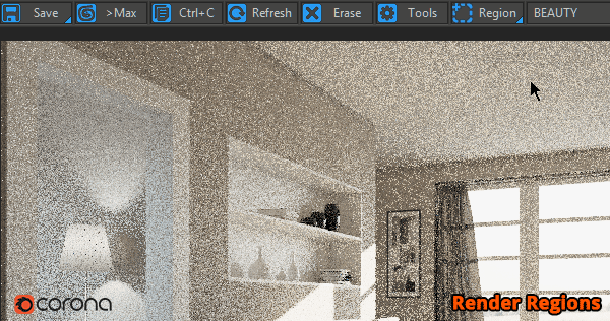Render Legion releases Corona 1.4 for 3ds Max
Render Legion has released Corona Renderer 1.4 for 3ds Max: a big update to the CPU-based production renderer that adds a new denoising function, support for multiple interactive render regions, and texture baking.
New render denoising functionality
We covered some of the features in Corona 1.4 when it was first previewed on Render Legion’s blog in February, but final release adds enough extra functionality that we thought it was worth a new story.
First up, there is the new denoising feature. According to Render Legion, it involves 3D noise analysis rather than being a 2D post process, but the upshot is what you’d expect: it enables renders to resolve faster.
The company’s blog claims “time reductions of 50% to 70% … in commercial usage” when using denoising over simply allowing the render to refine to the same point by conventional means.
There is also a new Beauty Pass render element, which enables users to render alternate versions of an image with different denoising settings, then composite them to generate a final-quality image.
Improved image sampling
Another factor improving the time-to-quality ratio of Corona renders is the introduction of Adaptive Image Sampling, to focus samples more intelligently in problem areas of renders, such as shadows.
Render Legion’s blog post doesn’t go into any more technical detail, but you can see before-and-after comparison images.

Updates to interactive rendering
The Virtual Frame Buffer also gets a couple of cool new features, including the option to save renders to a History buffer, then perform A/B comparisons on any two saved renders.
The VFB also gets support for multiple user-selected render regions (above) – including the option to move the regions around while an image is refining, enabling you to ‘paint in’ the parts of the render to refine first.
In addition, interactive rendering can now be performed on any render element.
Texture baking, new velocity pass, and a new VR camera type
Other new features include support for texture baking – there’s a complete new Render to Texture function, although the blog doesn’t go into detail – and a new velocity pass for adding motion blur in post.
The update also adds a new VR camera for rendering images in the equirectangular format used in, among others, YouTube’s 360-degree videos. Render Legion says it plans to “develop this functionality” in future.
Performance improvements across the board
There are also a number of performance boosts, including a “general speed improvement” of around 5-10%.
In addition, Corona objects now display using 3ds Max’s Nitrous viewport, raising frame rate by 30 times for the relatively complex test scene Render Legion has posted on its blog, which shows 100,000 instances.
Corona Scatter is now multi-threaded, giving a speed boost of “around 5 times on a typical quad-core i7” CPU.
And as promised in Render Legion’s original preview, handling of scenes with over 255 lights is now “more efficient” – although the official announcement still doesn’t put any figures on that one.
Other smaller improvements
There are also a number of ‘smaller’ improvements, some of them actually quite significant, like support for 3ds Max’s native normal maps and the option to show scattered objects in the viewport as point clouds.
You can see a full list on Render Legion’s blog.
Pricing and availability
Corona Renderer 1.4 for 3ds Max is available for 64-bit 3ds Max 2011+, running on Windows Vista and above.
Users have a choice between a perpetual ‘Box’ licence, which costs €449 (around $510), and a ‘Fair SaaS’ rental model, which costs between €24.99 and €44.99 a month ($28-50). You can find more details here.
Read a full list of new features in Corona Renderer 1.4 for 3ds Max on Render Legion’s blog
